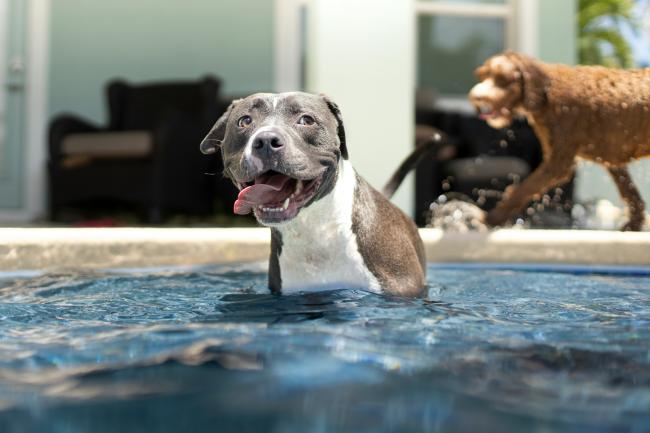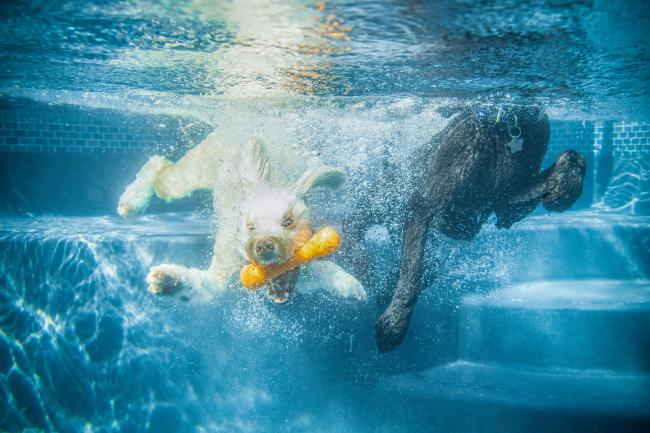Is my dog safe around the pool?
It is essential to understand the risks dogs face around pools and pool areas. From drowning to exposure to pool chemicals - understanding these potential dangers is necessary to ensure water safety.

Supervision Is Key:
Pool safety for both children and animals begins and ends with active supervision. Even dogs adept at swimming can sometimes face unexpected challenges. This makes it necessary to keep a keen eye on your dog's behaviour to promptly address any signs of distress.
Teach Swimming Skills:
Start with introducing your furry pal to the water gradually. Start in shallow areas where your dog can touch the ground and employ positive reinforcement through treats and praise. This is to instil a positive association with swimming.
You may find some dog breeds are more inclined to go swimming than others, with some, including many retrievers, actually bred for the purpose.
For dogs less enthusiastic to get in, you will need a gentler hand. Using a specially designed doggy life jacket is a good way to enhance buoyancy and foster confidence in the water. Combined with lots of positive reinforcement and lots of patience, you will see results.
One major reminder though is to never push your dog in when they are not ready or against their will. It is distressing for the animal and could inadvertently cause a life-long fear of the water.

Pool Access:
Self-latching pool fences are a legal requirement in Australian homes. Even when ensuring the fence is up to Australian standards, you will need to remain vigilant that it is closed and locking effectively.
Just as our pets learn to open the doors in our home, so they can learn to open an improperly closed pool fence.
While the gaps in fence palings easily keep children out, those with smaller dogs may find their pet can easily zip through. It may be necessary to install narrower fencing or extra barriers along the fence-line to restrict your dog's access to the water when supervision is not possible.
Safe Exit Points:
Once your dog is confident in the water and you are able to restrict their access when necessary, your next step is to teach your pal how to exit the pool safely.
Once they are in, guide them to the steps or shallow exit point and reinforce this behaviour through treats and positive techniques. Repeat this often until you are sure the dog knows the lay of the pool.
The risk of drowning from exhaustion is increased if the dog is unfamiliar with the pool and unsure of how to get out. Therefore it is very important for your dog to know how to exit the pool in the event your dog manages to swim unsupervised.

Pool Chemical Awareness:
Pool chemicals make for a sparklingly clean pool, but can also cause irritation to our furry friends in some circumstances.
Although it is not encouraged to let your dog drink from the pool, the concentrations of chemicals in the pool water itself are generally considered safe if they do.
That being said, it is very important to keep all chemicals in their concentrated form (eg chlorine tablets) secure and out of reach from prying noses. In their concentrated form they can cause harm and will require veterinary attention if ingested.
Here is a breakdown of the most common pool chemical systems and their relative risk.
Chlorinated Pools:
Chlorinated pools are the most common pool across Australia. While the chlorine levels are generally safe for humans, they can pose some risks to dogs. The chlorine in the water can irritate a dog's skin and eyes and in their concentrated form, chlorine tablets are quite corrosive.
You should rinse your dog thoroughly in fresh water after a swim and maybe consider some canine-friendly shampoos. Additionally, keep and eye on your dog's water consumption whilst in the pool to avoid chlorine ingestion.
Saltwater Pools:
Saltwater pools have gained popularity for their gentler approach to pool maintenance. While generally considered safer than chlorinated pools, high salt concentrations can be harmful to dogs if ingested. Regularly monitor your dog's salt intake, and provide fresh water to prevent them from drinking pool water. Rinse your dog after swimming to eliminate any salt residues on their fur.
Natural Pools:
Natural pools, with their chemical-free ecosystems, may seem like an ideal option. However, natural bodies of water, such as ponds or lakes, can harbour bacteria and parasites that pose health risks to dogs.
Before allowing your dog to enter natural pools, ensure the water is safe, and consider preventive measures like vaccinations and parasite control.
Regular Breaks:
Maintaining dog safety around pools necessitates acknowledging their physical limits. Dogs, like humans, can experience fatigue, particularly in water. Scheduling regular breaks for your dog to rest, rehydrate, and avoid excessive play will go a long way to preventing exhaustion.
Know Your Dog's Limits:
Central to dog safety is an understanding of your individual dog's preferences and capabilities. While some dogs eagerly embrace swimming, others may prefer lounging by the pool. Respect your dog's comfort level, and refrain from forcing them into the water if they are reluctant. This understanding is integral to both dog safety and effective dog training around pools.
Pool Toys and Distractions:
Floating toys designed for water play not only entertain but can also serve as effective distractions for your pet. There are a startlingly wide range of pool toys available for your doggy pal that can ensure a stimulating and quality pool play for your mate.
When selecting pool toys for your dog, prioritise safety by choosing toys appropriate for your pet's size and chewing habits. Regularly inspect toys for wear and tear, and replace them if necessary. More importantly - supervise your dog during water play to ensure a safe experience.

First Aid Preparedness:
Equipping yourself with knowledge of canine CPR and basic first aid for dogs is heavily recommended. In the event of an emergency, these skills serve as a lifeline, ensuring your dog's safety until you can seek veterinary care.
Prioritising pool safety for your pet not only helps to prevent accidents but makes for a more relaxed, enjoyable experience for you both on those hot summer days. Taking the time to make sure your dog is safe to swim in the pool safely and responsibly will only serve you and your furry friend for future summers.
Need a pet sitter this summer? Find one of our dedicated sitters today.





